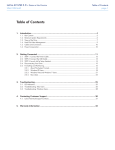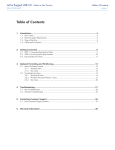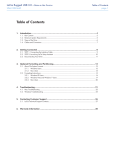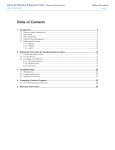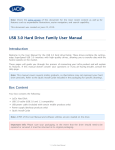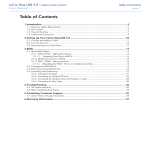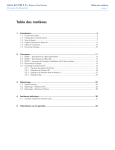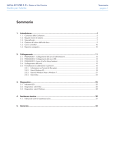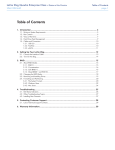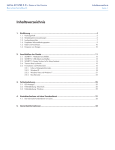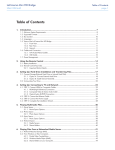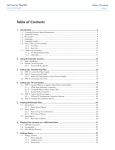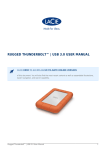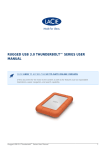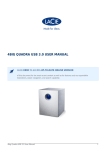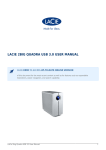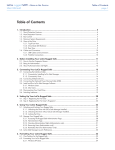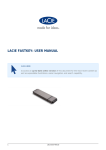Download LaCie 2TB d2 USB 3.0
Transcript
LaCie d2 USB 3.0 • Design by Neil Poulton User Manual Table of Contents page 1 Table of Contents 1.Introduction................................................................................................................. 4 1.1. 1.2. 1.3. 1.4. 1.5. 1.6. Box Content.................................................................................................................................. 5 Minimum System Requirements....................................................................................................... 6 Views of the Drive.......................................................................................................................... 7 Hard Disk Heat Management......................................................................................................... 9 Cables and Connectors................................................................................................................ 10 Power Conservation..................................................................................................................... 10 2. Getting Connected..................................................................................................... 11 2.1. 2.2. 2.3. 2.4. 2.5. STEP 1: Connect the Power Cable................................................................................................. 12 STEP 2: Connect the USB Cable................................................................................................... 13 STEP 3: Launch LaCie Setup Assistant............................................................................................ 14 Disconnecting Your Drive............................................................................................................. 15 Formatting and Partitioning.......................................................................................................... 16 2.5.1. About File System Formats................................................................................................ 16 2.5.2. Windows XP Users........................................................................................................... 18 2.5.3. Windows Vista and Windows 7 Users................................................................................ 21 2.5.4. Mac Users...................................................................................................................... 24 3.Troubleshooting......................................................................................................... 25 3.1. LED Indicators............................................................................................................................. 25 3.2. Troubleshooting: Mac Users......................................................................................................... 26 3.3. Troubleshooting: Windows Users.................................................................................................. 28 4. Contacting Customer Support.................................................................................... 30 4.1. LaCie Technical Support Contacts................................................................................................. 31 5. Warranty Information................................................................................................ 32 LaCie d2 USB 3.0 • Design by Neil Poulton User Manual Copyrights Copyright © 2011 LaCie. All rights reserved. No part of this publication may be reproduced, stored in a retrieval system, or transmitted in any form or by any means, electronic, mechanical, photocopying, recording or otherwise, without the prior written consent of LaCie. Trademarks Apple, Mac, and Macintosh are registered trademarks of Apple Inc. Microsoft, Windows 98, Windows 2000, Windows XP, Windows Vista, and Windows 7 are registered trademarks of Microsoft Corporation. Other trademarks mentioned in this manual are the property of their respective owners. Changes The material in this document is for information only and subject to change without notice. While reasonable efforts have been made in the preparation of this document to assure its accuracy, LaCie assumes no liability resulting from errors or omissions in this document, or from the use of the information contained herein. LaCie reserves the right to make changes or revisions in the product design or the product manual without reservation and without obligation to notify any person of such revisions and changes. Canada Compliance Statement This Class B digital apparatus meets all requirements of the Canadian InterferenceCausing Equipment Regulations. Japan Compliance Statement This is a Class B product based on the standard of the Voluntary Control Council for Interference from Information Technology Equipment (VCCI). If this is used near a radio or television receiver in a domestic environment, it may cause radio interference. Install and use the equipment according to the instruction manual. Foreword page 2 FCC Statement LaCie d2 USB 3.0 Tested to comply with FCC standards for home or office use This device complies with Part 15 of the FCC Rules. Operation is subject to the following conditions: ✦✦ The devices may not cause harmful interference ✦✦ The devices must accept any interference received, including interference that may cause undesired operation. NOTE: This equipment has been tested and found to comply with the limits for a Class B digital device, pursuant to Part 15 of the FCC Rules. These limits are designed to provide reasonable protection against harmful interference in a residential installation. This equipment generates, uses and can radiate radio frequency energy and, if not installed and used in accordance with the instructions, may cause harmful interference to radio communications. However, there is no guarantee that interference will not occur in a particular installation. If this equipment does cause harmful interference to radio or television reception, which can be determined by turning the equipment off and on, the user is encouraged to try and correct the interference by one or more of the following measures: ✦✦ Reorient or relocate the receiving antenna. ✦✦ Increase the separation between the equipment and receiver. ✦✦ Connect the equipment into an outlet on a circuit different from that to which the receiver is connected. ✦✦ Consult the dealer or an experienced radio/TV technician for help. Modifications to this product not authorized by LaCie could void the FCC & Industry Canada regulations and negate your authority to operate the product. 110415 v1.4 Manufacturer’s Declaration for CE Certification We, LaCie, solemnly declare that this product conforms to the following European standards: Class B EN60950, EN55022, EN55024, EN61000-3-2: 2000, EN610003-3: 2001 With reference to the following conditions: 2006/95/EC Low Voltage Directive; 2004/108/EC EMC Directive This symbol on the product or on its packaging indicates that this product must not be disposed of with your other household waste. Instead, it is your responsibility to dispose of your waste equipment by handing it over to a designed collection point for the recycling of waste electrical and electronic equipment. The separate collection and recycling of your waste equipment at the time of disposal will help to conserve natural resources and ensure that it is recycled in a manner that protects human health and the environment. For more information about where you can drop off your waste equipment for recycling, please contact your local city office, your household waste disposal service, or the shop where you purchased the product. CAUTION: Modifications not authorized by the manufacturer may void the user’s authority to operate this device. CAUTION: A shielded-type power cord is required in order to meet FCC emission limits and also to prevent interference to the nearby radio and television reception. It is essential that only the supplied power cord be used. LaCie d2 USB 3.0 • Design by Neil Poulton User Manual Health and Safety Precautions ✦✦ Only qualified persons are authorized to carry out maintenance on this device. ✦✦ Read this User Manual carefully and follow the correct procedure when setting up the device. ✦✦ Do not open a disk drive or attempt to disassemble or modify it. Never insert any metallic object into the drive to avoid any risk of electrical shock, fire, short-circuiting or dangerous emissions. The disk drive shipped with your LaCie d2 contains no user-serviceable parts. If it appears to be malfunctioning, have it inspected by a qualified LaCie Technical Support representative. ✦✦ Never expose your device to rain, or use it near water, or in damp or wet conditions. Never place objects containing liquids on the LaCie d2, as they may spill into its openings. Doing so increases the risk of electrical shock, short-circuiting, fire or personal injury. ✦✦ Use only the power supply shipped with the device. ✦✦ Do not use the LaCie d2 near other electrical appliances such as televisions, radios or speakers. Doing so may cause interference which will adversely affect the operation of the other products. ✦✦ Do not place the LaCie d2 near sources of magnetic interference, such as computer displays, televisions or speakers. ✦✦ Magnetic interference can affect the operation and stability of your LaCie d2. ✦✦ Never use excessive force on your LaCie d2. If you detect a problem, consult the Troubleshooting section in this manual. ✦✦ Protect your LaCie d2 from excessive exposure to dust during use or storage. Dust can build up inside the device, increasing the risk of damage or malfunction. ✦✦ Never use benzene, paint thinners, detergent or other chemical products to clean the outside of the LaCie d2. Such products will disfigure and discolor the casing. Instead, use a soft, dry cloth to wipe the device. General Use Precautions ✦✦ Power requirements 100-240 V~, 1.44 A, 50-60 Hz, (supply voltage fluctuations not exceeding ± 10% of the nominal and transient over-voltages according to over-voltage category II). ✦✦ Do not expose the LaCie d2 to temperatures outside the range of 5° C to 35° C (41° F to 95° F); or to operational humidity beyond 5-80%, non-condensing, or non-operating humidity beyond 10-90%, non-condensing. Doing so may damage the LaCie d2 or disfigure its casing. Avoid placing your LaCie d2 near a source of heat or exposing it to sunlight (even through a window). Inversely, placing your LaCie d2 in an environment that is too cold may damage the unit. ✦✦ Rated cooling for altitudes up to 2000 meters. ✦✦ Always unplug the LaCie d2 from the electrical outlet if there is a risk of lightning or if it will be unused for an extended period of time. Otherwise, there is an increased risk of electrical shock, short-circuiting or fire. IMPORTANT INFO: Any loss, corruption or destruction of data while using a LaCie drive is the sole responsibility of the user, and under no circumstances will LaCie be held liable for the recovery or restoration of this data. To help prevent the loss of your data, LaCie highly recommends that you keep TWO copies of your data; one copy on your external hard disk, for instance, and a second copy either on your internal hard disk, another external hard disk or some other form of removable storage media. If you would like more information on backup, please refer to our website. IMPORTANT INFO: 1TB (Terabyte) = 1,000GB. 1GB = 1000MB. 1MB = 1,000,000 Bytes. Total accessible capacity varies depending upon operating environment (typically up to 10% less per TB). Foreword page 3 LaCie d2 USB 3.0 • Design by Neil Poulton User Manual 1.Introduction Thank you for purchasing the LaCie d2 USB 3.0 Hard Disk. This manual will guide you through the process of connecting your drive to your computer and will assist you in troubleshooting any issues that might arise. If you encounter problems, first double-check the install steps in the printed Quick Install Guide, then consult this manual’s more detailed chapter on setup, then the troubleshooting chapter. The next step is to check out LaCie’s support page for this product, which contains a wealth of information, including interactive troubleshooting. Navigate to lacie.com/support and choose your product. If all else fails, consider posting a topic to the forum on lacielounge. com or Contacting Customer Support. Quick Links Click a topic: ✦✦ Getting Connected ✦✦ Cables and Connectors ✦✦ Formatting and Partitioning ✦✦ Troubleshooting Introduction page 4 LaCie d2 USB 3.0 • Design by Neil Poulton User Manual Introduction page 5 1.1. Box Content Your LaCie d2 package contains the items listed below: 1. LaCie d2 USB 3.0 2. External power supply 3. USB 3.0 cable (USB 2.0 and 1.1 compatible) 4. Quick Install Guide 5. Drive stand for upright use IMPORTANT INFO: Please save your packaging. In the event that the drive should need to be repaired or serviced, it must be returned in its original packaging. d2 USB 3.0 Design by Neil Poulton Quick Install Guide LaCie d2 USB 3.0 • Design by Neil Poulton User Manual 1.2. Minimum System Requirements ✦✦ Computer with a USB 2.0 or USB 3.0* port ✦✦ Latest version of Windows XP**, Windows Vista, Windows 7 / Mac OS X 10.5, 10.6 ✦✦ Minimum free disk space: 600MB recommended *To take advantage of SuperSpeed USB 3.0 transfer rates, the LaCie d2 USB 3.0 must be connected to a USB 3.0 port. If your computer does not have a USB 3.0 port, you may add a USB 3.0 PCI-Express card (desktop computer) or a USB 3.0 ExpressCard 34 (portable). LaCie offers a wide selection of peripherals, including expansion cards. Visit the LaCie web site at www.lacie.com/accessories. **Windows XP does not recognize partitions of more than 2TB. TECHNICAL NOTE: The USB 3.0 interface may require additional drivers to operate on your computer. Please confirm that your operating system supports USB 3.0 and download the necessary drivers. TECHNICAL NOTE: The LaCie d2 USB 3.0 is compatible with USB 3.0 and USB 2.0 interfaces. When attaching the d2 USB 3.0 to a USB 2.0 port, transfer rates are limited to USB 2.0 speeds (up to 480 Mb/s). Introduction page 6 LaCie d2 USB 3.0 • Design by Neil Poulton User Manual Introduction page 7 1.3. Views of the Drive Front View 1. Blue button: Serves as a LED drive status indicator and the power button. When you disconnect the interface cable, the drive will turn off. You can, however, turn the drive on by pressing the button, or off by pressing and holding it. (For information on power conservation, see 1.6. Power Conservation.) The LED remains lit to show that the drive is on, and blinks to indicate drive activity. For more information, refer to chapter 3.1. LED Indicators. Fig. 01 LaCie d2 USB 3.0 • Design by Neil Poulton User Manual Introduction page 8 Rear View 1. USB 3.0 port 2. Power adapter connection 3. Chain lock option CAUTION: To avoid overheating, the LaCie d2 should be installed in a well-ventilated area and in such a way as to maintain sufficient airflow across the controller chips. Also ensure that the Ventilation Fan is not obstructed. Environmental Requirements: Temperature: 0 – 35° C (32 – 95° F) Operation Humidity: 20 – 80%, non-condensing Storage Humidity: 10 – 90%, non-condensing Fig. 02 LaCie d2 USB 3.0 • Design by Neil Poulton User Manual Introduction page 9 1.4. Hard Disk Heat Management Heat Dissipation Design The LaCie d2 USB 3.0’s metal body is ideal for naturally dissipating internal drive heat. Its unique design actually draws heat away from the internal drive toward the external casing. The large surface area of the heat sink casing absorbs internal heat and dissipates it, keeping the drive safe and prolonging its life and reliability. As a consequence, it is normal that the external casing is warm to the touch. Please make sure that the vent on the back-bezel is not obstructed and that there is a natural airflow across the casing. Upright, Stack & Rackmount Configuration Heat dissipation is maximized when the d2 USB 3.0 is in the upright position. When stacking LaCie d2 USB 3.0s, please remember to attach the included rubber feet on the under side of your drives. This will allow for some airflow between your drives so that the heat dissipation can work effectively. CAUTION: To prevent overheating, do not stack more than three d2 USB 3.0 hard drives, especially if these drives are turned on simultaneously. Exclusive d2 Heat Sink Design Provides 60% more area for heat dissipation Heat Sink Design Standard Design LaCie d2 USB 3.0 • Design by Neil Poulton User Manual Introduction page 10 1.5. Cables and Connectors USB 3.0 USB is a serial input/output technology for connecting peripheral devices to a computer or to each other. SuperSpeed USB 3.0 is the latest implementation of this standard, and it provides higher bandwidth and new power management features. Transfer rates can attain up to 4.8 Gbits/s as opposed to USB 2.0’s 480 Mbits/s. This means USB 3.0 is theoretically up to ten times faster than its predecessor (although less in practice). Additionally, improved power management means peripherals will draw less electricity when inactive. Your LaCie drive is shipped with a SuperSpeed USB 3.0 cable to ensure maximum data transfer performance when connected to a compatible USB 3.0 port. The cable will also work when connected to a USB 2.0 or 1.1 port, but drive performance will be limited to their respective transfer rates. 1.6. Power Conservation The d2 USB 3.0 will shut off when: ✦✦ Shutting down the computer while the drive is connected and mounted on your computer.* ✦✦ You push and hold the front LED while the drive is powered on. The drive may take a few seconds to end any activity before powering down. Your LaCie d2 USB 3.0 also conserves energy by powering off the LED and entering Eco mode automatically if the drive has not been used for 30 minutes. The partition(s) will remain on the desktop (Mac) or in My Computer (Windows) while the drives stay in Eco mode until the d2 USB 3.0 is accessed. * This may vary with the computer or Operating System settings. Fig. 03 - USB 3.0 Cable Ends LaCie d2 USB 3.0 • Design by Neil Poulton User Manual 2.Getting Connected Installing the LaCie d2 USB 3.0 hard drive is easy for all users, regardless of operating system, thanks to LaCie Setup Assistant. Install your drive in three easy steps: 2.1. STEP 1: Connect the Power Cable 2.2. STEP 2: Connect the USB Cable 2.3. STEP 3: Launch LaCie Setup Assistant IMPORTANT INFO: Please follow the setup steps in the order they are given to ensure that the LaCie hard disk volume mounts correctly on your computer. Getting Connected page 11 LaCie d2 USB 3.0 • Design by Neil Poulton User Manual Getting Connected page 12 2.1. STEP 1: Connect the Power Cable 1. Connect the power supply to a wall outlet and to the LaCie d2 USB 3.0. 2. Continue to the next step, 2.2. STEP 2: Connect the USB Cable. CAUTION: Only use the AC adapter supplied with your specific LaCie device. Do not use a power supply from another LaCie device or another manufacturer. Using any other power cable or power supply may cause damage to the device and void your warranty. Always remove the AC adapter before transporting your LaCie drive. Failure to remove the adapter may result in damage to your drive and will void your warranty. You may use your LaCie drive when in a foreign country thanks to its 100-240 Volt power supply. To be able to use this feature, you may need to purchase an appropriate adapter or cord. LaCie accepts no responsibility for any damage to the drive resulting from the use of an inappropriate adapter. Using an adapter other than one authorized by LaCie will void your warranty. Fig. 04 LaCie d2 USB 3.0 • Design by Neil Poulton User Manual Getting Connected page 13 2.2. STEP 2: Connect the USB Cable 1. Connect the USB 3.0 cable to the drive and to a compatible port on your computer. 2. After a few seconds, a small LaCie partition will mount on your computer and appear in My Computer (Windows users) or on your desktop (Mac users). 3. Continue to the next step, 2.3. STEP 3: Launch LaCie Setup Assistant. TECHNICAL NOTE: If your computer does not have a USB 3.0 port, you can connect the included USB 3.0 cable to a USB 2.0 or USB 1.1 port. In this case, drive performance will be limited to their respective transfer rates. Fig. 05 LaCie d2 USB 3.0 • Design by Neil Poulton User Manual 2.3. STEP 3: Launch LaCie Setup Assistant Before using your drive, LaCie Setup Assistant software must be launched to format your drive. It will: ✦✦ Optimize your drive according to your needs ✦✦ Copy the manual and utilities onto your LaCie hard disk The LaCie Setup Assistant does not prevent you from using your computer’s native disk utility program to format or partition your LaCie drive. Simply follow the Setup Assistant through completion, then use your computer’s native disk utility (Disk Management for Windows or Disk Utility for Mac) to reformat your drive. See section 2.5. Formatting and Partitioning for more information. To launch LaCie Setup Assistant: Windows users: double click on the LaCie icon in “My Computer” (or in “Computer” for Windows Vista users). Mac users: double click on the “LaCie Setup Assistant” icon which will appear on your desktop. If you do not launch LaCie Setup Assistant or if you quit LaCie Setup Assistant after the formatting has begun, your drive will not be ready to use and will require manual formatting. The user manual and utilities will not be available on your drive and will have to be downloaded from the LaCie website: www.lacie.com. IMPORTANT INFO: LaCie recommends that you copy the user manual and utilities onto your computer’s internal hard drive or other medium when setup is complete. Getting Connected page 14 LaCie d2 USB 3.0 • Design by Neil Poulton User Manual Getting Connected page 15 2.4. Disconnecting Your Drive USB external devices feature “plug & play” connectivity, which means that your drive can be connected and disconnected while the computer is running. To prevent failures, however, it is important to follow these steps when disconnecting your LaCie drive. Windows XP Users From the System Tray (located in the lower right-hand side of your screen), click the Eject icon (a small green arrow over a hardware image) (Fig. 06). Fig. 06 A message will appear, listing the devices the Eject icon controls (it should say, “Safely remove...”). Click on the LaCie hard disk in this prompt. This message will appear: “Safe to Remove Hardware” (or similar). It is now safe to disconnect the device. Windows Vista & Windows 7 Users From the System Tray (located in the lower right-hand side of your screen) click on the plug icon (note the white check mark inside a green circle) (Fig. 07). Fig. 07 A message will appear, detailing the devices that may be safely unmounted. Select Eject for the device you wish to unmount (Fig. 08). A message will appear notifying you that it is safe to remove the device. Mac Users Drag the hard drive icon to the trash (Fig. 09). (The icon pictured below is a generic USB device icon. Your drive may be represented by an icon that looks like the drive itself.) Fig. 08 When the icon disappears from the desktop, the drive can be disconnected. Fig. 09 LaCie d2 USB 3.0 • Design by Neil Poulton User Manual Getting Connected page 16 2.5. Formatting and Partitioning LaCie Setup Assistant should be run once when you first connect your drive. During this process, the drive will be formatted for your needs. However, if you aborted the process or if you wish to reformat your drive after you’ve completed the Setup Assistant, read this chapter for formatting and partitioning information. See sections 2.5.2 to 2.5.4 for formatting instructions. 2.5.1. About File System Formats Windows Users FAT 32: FAT is an acronym for File Allocation Table, which dates back to the beginnings of DOS programming. Originally, FAT was only 16 bits, but after the second release of Windows 95 it was upgraded to 32 bits, hence the name FAT 32. In theory, FAT 32 volume sizes can range from less than 1MB all the way to 2TB. It is the native file system of Windows 98 and Windows Me, and is supported by Windows 2000, Windows XP, Windows Vista, and Windows 7. When FAT 32 is used with Windows 2000, Windows XP, Windows Vista, and Windows 7 however, volume size is limited to 32GB (by the Windows partition utility, i.e. Disk Manager), and the individual file size is limited to 4GB. NTFS: This acronym stands for New Technology Filing System, and it is the native file system for Windows NT, Windows 2000, Windows XP and Windows Vista. NTFS offers several features that are not available with FAT 32; i.e. file compression, encryption, permissions, and auditing, as well as the ability to mirror drives and RAID 5 capabilities. The minimum supported volume size for NTFS is 10MB, with a maximum of 2TB when initialized in MBR format or without a limit when initialized in GPT format, with no limit to file size. Volumes created in NTFS can only be directly accessed (not through shares) by Windows NT, Windows 2000, Windows XP, Windows Vista, and Windows 7 without resorting to help from third-party products. Windows File System Formats There are two possible file system format categories for Windows users: NTFS and FAT 32 (MS-DOS). See the table below for more information. Use NTFS if: ...you will be using the drive only with Windows XP (performance will generally be greater when compared to FAT 32). This file system is compatible in read only mode with Mac OS 10.3 and higher. Use FAT32 if: ...you will be using your drive with both Windows and Mac OS 9.x or 10.x or sharing the drive between Windows 2000, 98 SE, XP, Vista, and Windows 7. Maximum single file size is 4GB. LaCie d2 USB 3.0 • Design by Neil Poulton User Manual Getting Connected page 17 Mac OS Users You may customize the drive by reformatting and/or partitioning the drive with separate file system formats. For optimal performance in Mac OS environments, format and partition the drive as one large Mac OS Extended volume. Mac OS Extended (HFS+): Mac OS Extended refers to the file system used by Mac OS X. HFS+ represents an optimization of the older HFS file system by using hard disk space more efficiently. With HFS+, you are no longer limited by block size. MS-DOS File System (FAT 32): This is the Microsoft file system, more typically known as FAT 32. This is the file system to use if you are going to be using your LaCie Hard Drive between Macs and Windows operating systems. Mac File System Formats There are two possible file system format categories for Mac users: Mac OS Extended (HFS+) and FAT 32 (MS-DOS). See the table below for more information. Use HFS+ if: ...you will be using the drive on Macs only; performance will generally be greater when compared to FAT 32. This file system is NOT compatible with Windows OS. Use FAT32 if: ...you will be using your drive with both Windows and Mac OS 9.x or 10.x or sharing the drive between Windows 2000, 98 SE, XP, Vista, and Windows 7. Maximum single file size is 4GB. LaCie d2 USB 3.0 • Design by Neil Poulton User Manual Getting Connected page 18 2.5.2. Windows XP Users The steps listed below will help you format and partition your disk drive using Windows XP. For more information on choosing the optimal file format, refer to 2.5.1. About File System Formats. CAUTION: Following these steps will erase everything from the d2 hard drive. If you have information that you want to protect or continue to use, back up this information before performing these steps. 1. Make sure the drive is connected to and mounted on the computer. Fig. 10 2. Right-click My Computer and select Manage. 3. From the “Computer Management” window, select Disk Management (located below the Storage group). 4. If the “Initialize and Convert Disk Wizard” window appears, click Cancel. 5. Windows will list the hard drives that are installed on the system. Locate your LaCie hard disk drive (Fig. 10). If there is a red circle with a white line, you must initialize the disk. Right-click the icon to select Initialize. 6. In the rectangular box to the right that says “Unallocated” or lists partitions from a previous format, right-click and select New Partition… 7. On the first page of the New Partition Wizard, click Next (Fig. 11). 8. Select the Primary or Extended option (Fig. 12) and click Next. Fig. 11 continued on next page >> Fig. 12 LaCie d2 USB 3.0 • Design by Neil Poulton User Manual Getting Connected page 19 9. Specify the partition size. Please note that FAT32 partitions must be 32GB (32000MB) or smaller. By default, the partition occupies the entire volume (Fig. 13) but you may change the size based upon the working environment. Click Next. 10.Assign a drive letter or mount path (Fig. 14). Click Next . 11.Select the file format for the disk (FAT32 will only appear as an option if the partition is 32GB or less - see 2.5. Formatting and Partitioning). Once FAT32 or NTFS has been selected (Fig. 15), you have the option to Perform a quick format, which allows for a much faster format. While Disk Management does not check the drive for errors as extensively with a quick format, the option does save time. Click Next. continued on the next page >> Fig. 13 Fig. 14 Fig. 15 LaCie d2 USB 3.0 • Design by Neil Poulton User Manual Getting Connected page 20 12.A window appears listing your choices. If all seems well, click Finish to begin the format process (Fig. 16). To make a change, select Back. 13.Your drive’s partition(s) should have a “Healthy” status in the list of drives in Disk Management (Fig. 17). You will also see the drive’s partition(s) in My Computer. The drive is ready for use. Fig. 16 Fig. 17 LaCie d2 USB 3.0 • Design by Neil Poulton User Manual Getting Connected page 21 2.5.3. Windows Vista and Windows 7 Users The following steps explain how to format your LaCie hard disk using Windows Vista or Windows 7. CAUTION: Following these steps will erase everything from the d2 hard drive. If you have information that you want to protect or continue to use, back up this information before performing these steps. 1. Right-click Computer and choose Manage. From the Manage window select Disk Management. 2. From the list of drives in the middle of the Disk Management window, right-click your LaCie hard drive and select New Simple Volume... (Fig. 18). 3. The New Simple Volume Wizard will appear. To continue choose Next> (Fig. 19). Fig. 18 4. This wizard allows you to create volumes, also known as partitions. You can choose to create a single partition or many. Type the size of the partition you want to create in megabytes (MB). For example, a 100GB (gigabyte) partition is 100000MB. If you want to create a FAT32 partition, the size cannot exceed 32GB (32000MB) (Fig. 20). Once you have chosen a partition size, select Next>. continued on the next page>> Fig. 19 Fig. 20 LaCie d2 USB 3.0 • Design by Neil Poulton User Manual Getting Connected page 22 5. Assign a drive letter or accept the default (Fig. 21). Select Next>. 6. Choose the file system format for the partition. If the partition size is 32GB or less, the choices will include NTFS and FAT32. Select the format and check Perform a quick format (Fig. 22). Select Next>. TECHNICAL NOTE: Windows Vista SP1 and Windows 7 offer the exFAT file system, which is not limited to partitions greater than 32GB (Fig. 23). Used primarily with USB flash drives, the exFAT file system overcomes many of the limitations of FAT32. In addition to Windows Vista SP1 and Windows 7, the exFAT file system can work on Windows XP SP2 with a special driver. Since Mac OS support is unstable, sharing your LaCie drive between Windows and Apple operating systems using this file format is discouraged. Fig. 21 continued on the next page>> Fig. 22 Fig. 23 LaCie d2 USB 3.0 • Design by Neil Poulton User Manual Getting Connected page 23 7. The last window is a summary of the format options you have just selected. If all looks to be correct, click Finish for the format to begin (Fig. 24). Fig. 24 LaCie d2 USB 3.0 • Design by Neil Poulton User Manual Getting Connected page 24 2.5.4. Mac Users CAUTION: Following these steps will erase everything from the d2, including encrypted data. If you have information that you want to protect or continue to use, back up this information before performing these steps. 1. Connect the drive to the power source and to the computer via the interface port. 2. Select Utilities from the Go menu in the Finder menu bar. 3. In the Utilities folder, double-click Disk Utility. 4. The Disk Utility window will open (Fig. 25). Select the volume labeled LaCie Hard Disk from the list of available hard disks on the left side of the window. 5. Select the Partition tab. 6. From the Volume Scheme: menu, choose the number of partitions you want to divide the drive into (Mac OS X gives you the option of dividing the drive into at most 16 partitions). You can adjust the size of each partition using the slide bar between the partitions in the Volume Scheme: area. 7. In the Volume Information section, enter a name for each volume (partition), choose the volume file system format. IMPORTANT INFO: Please refer to section 2.5.1. About File System Formats, for a more detailed comparison of the various file system formats. 8. Once you have finalized the volume options, click Partition. Click Partition again when the alert message appears to continue. 9. Mac Disk Utility will format and partition the disk according to your settings, and your drive will be ready to use. Fig. 25 LaCie d2 USB 3.0 • Design by Neil Poulton User Manual Troubleshooting page 25 3.Troubleshooting In the event that your LaCie d2 is not working correctly, please refer to the tables on the following pages to troubleshoot the device. If you have gone through all of the points in the table and your drive is still not working correctly, please see the FAQs that are regularly published on our Web site – www.lacie.com. One of these FAQs may provide an answer to your specific question. You can also visit the drivers pages, where the most recent software updates will be available. If you need further assistance, please contact your LaCie reseller or LaCie Technical Support (see section 4. Contacting Customer Support for details). 3.1. LED Indicators Front LED Color d2 USB 3.0 State Light blue The product is connected to a USB 2.0 port Solid blue The product is connected to a USB 3.0 port Blinking blue The product is starting up; will become solid blue once drive is initialized Off The d2 is powered off, system failure, or electronic board failure; contact LaCie customer support Manual Updates LaCie is constantly striving to give you the most up-to-date, comprehensive user manuals available on the market. It is our goal to provide you with a friendly, easy-to-use format that will help you quickly install and utilize the many functions of your new device. If your manual does not reflect the configurations of the product that you purchased, please check our Web site for the most current version available. www.lacie.com LaCie d2 USB 3.0 • Design by Neil Poulton User Manual Troubleshooting page 26 3.2. Troubleshooting: Mac Users Problem Question Solutions The drive is not recognized by the computer. Does an icon for the drive appear on the desktop? There should be an icon for the LaCie drive on the desktop (unless you’ve set the Finder preference not to show External disks on the desktop). If the drive does not appear, follow the rest of the Troubleshooting tips to isolate the problem. Does your computer’s configuration meet the minimum system requirements for use with this drive? See section 1.2. Minimum System Requirements for more information. Also, try changing the computer you are using. Computer problems can manifest themselves in many ways. Even if the computer appears to be working properly, this is a worthwhile test. Is the drive’s power supply connected? Make sure that the power supply is properly connected (see section 2.1. STEP 1: Connect the Power Cable) and that the outlet the power supply is connected to is working. Did you follow the correct installation steps for the specific interface and operating system? Review the installation steps in section 2. Getting Connected. Are both ends of the USB cable securely attached? Only use a USB cable provided by LaCie. Check both ends of the USB cable to make sure they are fully seated in their respective ports. Try disconnecting the cables, waiting 10 seconds, and then reconnecting them. If the drive is still not recognized, restart your computer and try again. Is there a conflict with other device drivers or extensions? Contact LaCie Technical Support for help. Does your computer’s operating system support the file system? Check your computer’s documentation and see section 2.5. Formatting and Partitioning for more information. Time Machine won’t recognize my drive as compatible. How is your drive formatted? Time Machine is compatible only with disks formatted in HFS+ (journaled), not FAT32. The solution is to reformat the drive (see section 2.5. Formatting and Partitioning). Error messages under Mac OS 10.x. Did you get an “Error –50” message while copying to a FAT 32 (MS-DOS) volume? When copying files or folders from Mac OS 10.x to a FAT 32 volume, file names with certain characters cannot be copied. These characters include, but are not limited to: ?<>/\: Check your files and folders to ensure that these types of characters are not being used. LaCie d2 USB 3.0 • Design by Neil Poulton User Manual Troubleshooting page 27 Problem Question Solutions The drive is not running noticeably faster when connected via USB 3.0. Is the drive connected to a standard USB (2.0 or 1.1) port on your computer? If your drive is connected to a standard USB (2.0 or 1.1) port, this is normal. A USB 3.0 device can only operate at USB 3.0 performance levels when it is connected directly to a USB 3.0 port. Otherwise, the USB 3.0 device will operate at the slower USB transfer rates. For more information, please see section 1.5. Cables and Connectors. Check to see that the USB 3.0 drivers for both your host bus adapter and device have been installed correctly. If in doubt, uninstall the drivers and re-install them. Also, make sure that you are connected directly to a Hi-Speed USB 3.0 port on your computer. Does your computer or operating system support Hi-Speed USB 3.0? The drive is making clicking noises. See section 1.2. Minimum System Requirements for more information. Is the sound “soft clicking” or “hard clicking”? Soft clicking can be the normal sound of the drive working. If the drive is functional, this is normal. Drives do not typically give an indication of any problems prior to failure, so it does not mean it is about to fail if the drive is making a clicking sound and still functioning. If the drive is non-functional, there are two possible causes: ✦✦ The drive could be corrupted. Reformatting the drive can solve this issue. ✦✦ The drive could have a failure in the external power supply or power cable. Try using a different one, if possible. Hard clicking is a very noticeable sound, and is akin to hearing metal-on-metal impacts. Hard clicking may be a sign of physical failure. If nothing traumatic happened to the drive prior to this behavior, consider it to be soft clicking, and troubleshoot the problem as suggested above. The drive does not turn on automatically when connected to the computer. The automatic power on/off feature works by measuring power changes in the data cable. Unfortunately, not all computers change the amount of power coming from those ports. As the power amount doesn’t change, the drive is unaware when to shut down. Verify this by shutting down the computer, then unplug the computer from power for a while. The drive will shut down when the power stops coming from the ports. Available disk spaces does not increase after deleting files. When a file is deleted, the space used on the disk is not reclaimed until the file is truly erased. The trash (Recycle Bin on Windows) is actually a hidden folder located in each hard drive. To completely delete the file, another step must be performed. To remove the file and reclaim the space, click the Trash icon. A Finder window will appear with an Empty button in the upper right. Click that button. After formatting, the drive volume is less than advertised. After formatting, the available capacity of a drive will show less than advertised on the box. Simply put, the issue is related strictly to mathematics. The exact same hard drive containing 500,000,000,000 bytes divided by 1,000,000,000 will equal 500GB (as shown on the box by the manufacturer); but divided by 1,073,741,824 by the computer after formatting will show 466GB. Remember, its the same amount of bytes, just divided into “gigabytes” differently. LaCie d2 USB 3.0 • Design by Neil Poulton User Manual Troubleshooting page 28 3.3. Troubleshooting: Windows Users Problem Question Solutions The drive is not recognized by the computer. Has the drive been formatted? Make sure that the drive has been formatted properly. Please see section 2.5. Formatting and Partitioning. Does your computer’s operating system support the file system? Check your computer’s documentation and see section 1.2. Minimum System Requirements. Is there an icon for the drive in My Computer? Go into My Computer and look for an icon and drive letter assigned to the LaCie drive. If the drive does not appear, follow the rest of the Troubleshooting tips to isolate the problem. Go into My Computer and look for an icon and drive letter assigned to the LaCie drive. If the drive does not appear, follow the rest of the Troubleshooting tips to isolate the problem. Does your computer’s configuration meet the minimum system requirements for use with this drive? See section 1.2. Minimum System Requirements for more information. Is the drive’s power supply connected? Make sure that the power supply is properly connected (see section 2.1. STEP 1: Connect the Power Cable) and that the outlet the power supply is connected to is working. Did you follow the correct installation steps for the specific interface and operating system? Review the installation steps in section 2. Getting Connected. Are both ends of the USB cables firmly attached? Check both ends of the USB cable to make sure they are fully seated in their respective ports. Try disconnecting the cables, waiting 10 seconds, and then reconnecting them. If the drive is still not recognized, restart your computer and try again. Is there a conflict with other device drivers or extensions? Contact LaCie Technical Support for help. Is the drive connected to a standard USB (2.0 or 1.1) port on your computer? If your drive is connected to a standard USB (2.0 or 1.1) port, this is normal. A USB 3.0 device can only operate at USB 3.0 performance levels when it is connected directly to a USB 3.0 port. Otherwise, the USB 3.0 device will operate at the slower USB transfer rates. For more information, please see section 1.5. Cables and Connectors. Does your computer or operating system support SuperSpeed USB 3.0? Check to see that the USB 3.0 drivers for both your host bus adapter and device have been installed correctly. If in doubt, uninstall the drivers and re-install them. Also, make sure that you are connected directly to a Hi-Speed USB 3.0 port on your computer. The drive is not running noticeably faster when connected via the SuperSpeed USB 3.0 cable. LaCie d2 USB 3.0 • Design by Neil Poulton User Manual Problem Question The drive is making clicking noises. Is the sound “soft clicking” or “hard clicking”? Troubleshooting page 29 Solutions Soft clicking can be the normal sound of the drive working. If the drive is functional, this is normal. Drives do not typically give an indication of any problems prior to failure, so it does not mean it is about to fail if the drive is making a clicking sound and still functioning. If the drive is non-functional, there are two possible causes: ✦✦ The drive could be corrupted. Reformatting the drive can solve this issue. ✦✦ The drive could have a failure in the external power supply or power cable. Try using a different one, if possible. Hard clicking is a very noticeable sound, and is akin to hearing metal-on-metal impacts. Hard clicking may be a sign of physical failure. If nothing traumatic happened to the drive prior to this behavior, consider it to be soft clicking, and troubleshoot the problem as suggested above. The drive does not turn on automatically when connected to the computer. The automatic power on/off feature works by measuring power changes in the data cable. Unfortunately, not all computers change the amount of power coming from those ports. As the power amount doesn’t change, the drive is unaware when to shut down. Verify this by shutting down the computer, then unplug the computer from power for a while. The drive will shut down when the power stops coming from the ports. Available disk spaces does not increase after deleting files. When a file is deleted, the space used on the disk is not reclaimed until the file is truly erased. The trash (Recycle Bin on Windows) is actually a hidden folder located in each hard drive. To completely delete the file, another step must be performed. To empty this folder and reclaim the space, right-click the Recycle Bin icon, and left-click Empty Recycle Bin on the menu that appears. LaCie d2 USB 3.0 • Design by Neil Poulton User Manual 4.Contacting Customer Support Before You Contact Technical Support 1. Read the manuals and review section 3. Troubleshooting. 2. Try to isolate the problem. If possible, make the drive the only external device on the CPU, and make sure that all of the cables are correctly and firmly attached. If you have asked yourself all of the pertinent questions in the troubleshooting checklist, and you still can’t get your LaCie drive to work properly, contact us at www.lacie.com. Before contacting us, make sure that you are in front of your computer and that you have the following information on hand: Information Where to Find Information 1. LaCie hard drive serial number Located on a sticker at the back of drive or on the original packaging 2. Macintosh/PC model Mac users: Click on the Apple icon in the menu bar and select About This Mac. 3. Operating system version 4. Processor speed 5. Computer memory 6. The brands and models of other internal and external peripherals installed on your computer Windows users: Right click My Computer and select Properties > General. Mac users: Click on the Apple icon in the finder bar and select About This Mac. Select More Info... The Apple System Profiler will launch and will list your internal and external peripherals. Windows users: Right click My Computer and select Properties > Hardware. Contacting Customer Support page 30 LaCie d2 USB 3.0 • Design by Neil Poulton User Manual Contacting Customer Support page 31 4.1. LaCie Technical Support Contacts LaCie Australia http://www.lacie.com/au/contact/ LaCie Belgium http://www.lacie.com/be/contact/ (Dutch) http://www.lacie.com/befr/contact/ (French) LaCie Brazil http://www.lacie.com/us/contact/ LaCie Canada http://www.lacie.com/ca/contact/ (English) http://www.lacie.com/cafr/contact/ (French) LaCie China http://www.lacie.com/cn/contact/ LaCie Denmark http://www.lacie.com/dk/contact/ LaCie Finland http://www.lacie.com/fi/contact/ LaCie France http://www.lacie.com/fr/contact/ LaCie Germany http://www.lacie.com/de/contact/ LaCie Ireland http://www.lacie.com/ie/contact/ LaCie Italy http://www.lacie.com/it/contact/ Japan – Elecom Co., LTD http://www.lacie.jp LaCie Korea http://www.lacie.com/kr/contact/ LaCie Latin America http://www.lacie.com/us/contact/ LaCie Netherlands http://www.lacie.com/nl/contact/ LaCie Norway http://www.lacie.com/no/contact/ LaCie Portugal http://www.lacie.com/pt/contact/ LaCie Singapore http://www.lacie.com/asia/contact/ LaCie Southeast Asia http://www.lacie.com/sea/contact/ LaCie Spain http://www.lacie.com/es/contact/ LaCie Sweden http://www.lacie.com/se/contact/ LaCie Switzerland http://www.lacie.com/ch/contact/ (German) http://www.lacie.com/chfr/contact/ (French) http://www.lacie.com/chit/contact/ (Italian) LaCie UK http://www.lacie.com/uk/contact/ LaCie USA http://www.lacie.com/us/contact/ (English) http://www.lacie.com/uses/contact/ (Spanish) LaCie Grand Export http://www.lacie.com/intl/contact/ LaCie d2 USB 3.0 • Design by Neil Poulton User Manual Warranty Information page 32 5.Warranty Information This Limited Warranty applies only to hardware products manufactured by or for LaCie that can be identified by the “LaCie” trademark, trade name, or logo affixed to them. The Limited Warranty does not apply to any non-LaCie hardware products or any software, even if packaged or sold with LaCie hardware. Manufacturers, suppliers, or publishers, other than LaCie, may provide their own warranties to the end user purchaser, but LaCie, in so far as permitted by law, provides their products “as is”. Software distributed by LaCie with or without the LaCie brand name (including, but not limited to system software) is not covered under this Limited Warranty. Refer to the licensing agreement accompanying the software for details of your rights with respect to its use. LaCie does not warrant that the operation of the product will be uninterrupted or error-free. LaCie is not responsible for damage arising from failure to follow instructions relating to the product’s use. This warranty does not apply: ✦✦ to consumable parts, unless damage has occurred due to a defect in materials or workmanship; ✦✦ to cosmetic damage, including but not limited to scratches, dents and broken plastic on ports; ✦✦ to damage caused by use with non-LaCie products; ✦✦ to damage caused by accident, abuse, misuse, flood, fire, earthquake or other external causes; ✦✦ to damage caused by operating the product outside the permitted or intended uses described by LaCie; ✦✦ to damage caused by service (including upgrades and expansions) performed by anyone who is not a representative of LaCie or a LaCie Authorized Service Provider; ✦✦ to a product or part that has been modified to alter functionality or capability without the written permission of LaCie; or ✦✦ if any LaCie serial number on the product has been removed or defaced. To obtain warranty service, call LaCie Technical Support. You will be asked to provide your LaCie product’s serial number, and you may be asked to furnish proof of purchase to confirm that the drive is still under warranty. All drives returned to LaCie must be securely packaged in their original box and shipped with postage prepaid. IMPORTANT INFO: Register online for free technical support: www.lacie.com/register
































